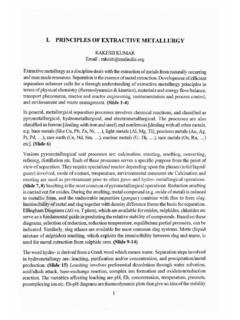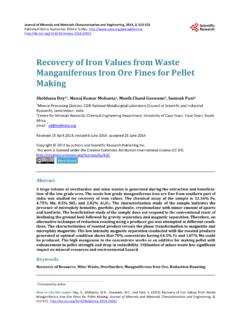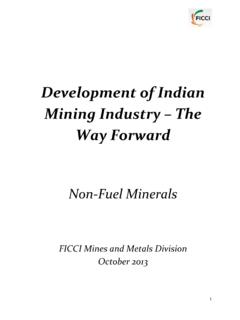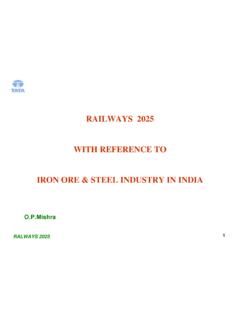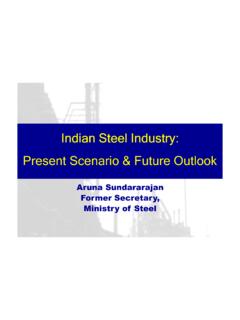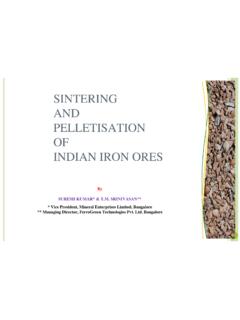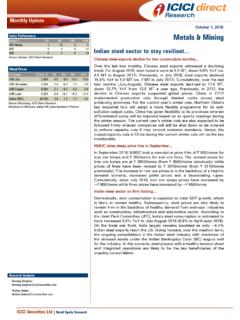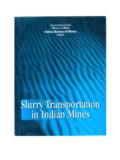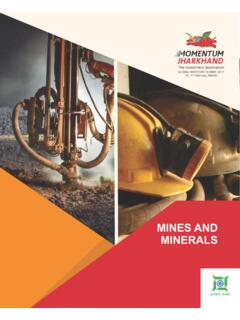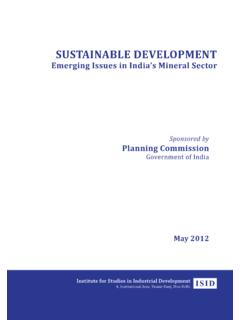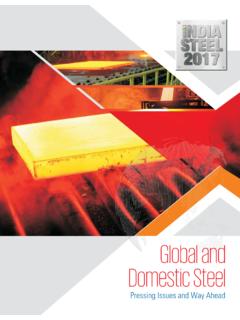Transcription of A brief history of the Indian iron and steel industry
1 A brief history of the Indian iron and steel industry K. N. P. R A 0 , (Met.), EARLY history THE ART of making iron by smelting iron ore was known and practised in India from very early times, and the iron and steel produced were shaped into various useful articles. Sushruta, (3rd or 4th century ) a great authority on medical science in ancient India, described in his book a hundred different surgical instruments. Ancient Indian literature abounds in vivid descriptions of swords, spears, and other steel weapons. There is ample evidence that the manufacture of iron and steel in India is of great antiquity and that India excelled in the quality of her manufacture. To give a few examples : King Porus is said to have presented 100 ta-lents of Indian iron to Alexander the Great, when he inva-ded India. The famous Damascus swords of olden days were fashioned out of Indian steel .
2 The most striking evidence of the skill attained by the early ironmasters is to be found in the well-known iron Pillar (300 ) in Delhi (Fig. 1). Nearly 20 ft high and weighing over 6 tons, this unique pillar is not a casting. It was made by welding together discs of forged iron and is remark-ably free from corrosion. How it was produced is as much a mystery as the Pyramids of Egypt. The following quotations bear testimony to the skill of the ancient iron craftsmen in India : `The antiquity of the Indian process is no less asto-nishing than its ingenuity. We can hardly doubt that the tools with which the Egyptians covered their obe-lisks and temples of porphyry and syenite with hiero-glyphics were made of Indian steel . There is no evi-dence to show that any of the nations of antiquity besides the Hindus were acquainted with the art of making steel .
3 The references which occur in Greek and Latin writers on this subject, served only to add to their ignorance of it ; they were acquainted with the qualities and were familiar with the use of steel , but they appear to have been altogether ignorant of the mode by which it was prepared from iron The claims of India to a discovery which has exercised more influence upon the arts conducing to civilisation and the manufacturing industry than any other within the whole range of human invention is altogether un-questioned'. Heath (1839). `The Hindus excel in the manufacture of iron . They have also. workshops wherein are forged the most famous sabres in the world. It is impossible to surpass the edge you get from Indian steel .' Arab Edrisi. `Without doubt, therefore, the process of making iron and steel has been used in India for thousands of years It may, therefore, easily have been the case that the ancient Egyptians were familiar with Indian iron and steel and either imported the material or ob-tained the services of Indian workers in metals to produce the necessary material for the tools employed on the great stone monuments.
4 ' Sir Robert Hadfield. history is a record. of the rise and decay of civiliza- tions. India's is no exception. With the passage of time, the art of the manufacture of iron and steel in which the Mr Rao is with the Tata iron and steel Co. Ltd, Jamshedpur. ancient Indian had attained such proficiency languished and died. Meanwhile, in Europe and America an industrial .revolution was taking place. The most important deve-lopment was the manufacture of iron and steel on a com-mercial scale on modern lines. Science and technology combined to perfect an industry , the importance of which is immense. Production was stepped up from decade to decade at a spectacular rate, and with it the wealth, power, and general prosperity of the producing countries increased. Ironically enough, during this period of intense activity and progress in other parts of the globe, all that India possessed was a few primitive devices for produc-ing small quantities of iron from indigenous ore mined in an equally primitive way.
5 During the 18th and 19th centuries, some attempts were made to develop an iron and steel industry in India, but these proved a failure. The first attempt to establish an iron and steel indus-try on modern lines was made in 1830, by Josiah Mar-shall Heath, a member of the Civil Service of the East India Company. After leaving the public service, he invested the whole of his fortune in a steel plant consist-ing of furnaces, forges, and rolling mills which he erected at Porto Novo on the Madras coast in 1833. The steel produced was of good quality and was expor-ted to England, where some was used for the construc-tion of the Menai and Britannia tubular bridges. The venture failed, however, because of insufficient finance, the inexperience of the men, and the inadequacy of the equipment. At one time, Heath's blowing machine was run by bullocks ! There was also difficulty in obtaining sufficient fuel.
6 The foundation of India's present iron and steel in-dustry was not laid until 1875, when a blast-furnace plant was built at Kulti, 145 miles west of Calcutta. The undertaking suffered many ups and downs until it passed into the hands of the Bengal iron and steel Company and later the Indian iron and steel Company. BEGINNINGS OF THE MODERN iron AND steel industry It was in the eighties of the last century that Jamsetji Nusserwanji Tata, the far-sighted Indian industrialist, set to work on his dream of a modern-54-616 plant. He started prospecting for the principal law material, iron ore. For over twenty years, he could make no progress, because of the restrictive mining laws in force at the time. Referring to these laws, Lovat Fraser remarks `The Indian regulations for mining and proSpecting seem-ed carefully devised to obstruct and prevent develop-ment.
7 It is hardly possible to estimate all the mischief that single enactment did in retarding the development of the mineral resources of India.' Undaunted, Tata made personal approaches to Sir George Hamilton, then Secretary of State for India in the British Government, and the Viceroy, Lord Curzon, and by sheer persistence succeeded in getting the laws amended in 1899. Thus it was only at the turn of this century that the way was paved for industrial steelmaking in India. In 1903, Tata started prospecting operations with the help of I Rao : brief history of Indian iron and steel industry Weld, an American geologist. The first discovery was that of the Dhalli Rajhara iron -ore deposits of Madhya Pradesh, from which the Government steel plant at Bhilai is now drawing its supplies. For a time, it was thought that the site for the Tata plant would be located in Madhya Pradesh.
8 However, the subsequent discovery by P. N. Bose of the rich iron -ore belt of Mayurbhanj and Keonjhar in Bihar and Orissa decided the location of the Tata iron and steel Works at a village named Sakchi, around which Jamshedpur has grown. The situa-tion was ideal, as the ore could be had from Goruma-hisani 45 miles away, coal from the Maria coal fields 100 miles away, and the busy port of Calcutta, which was the natural outlet for the export of the greater part of the saleable steel and import of machinery was only 150 miles away. The rivers Subarnarekha and Kharkai provide a constant source of water supply, vital for the steel plant and-the township. The Tata iron and steel Co. Ltd The Tata iron and steel Company was formed in 1907, and the construction of the steelworks was started a year later. Pig iron was first made in 1911, and the first ingot of steel was rolled in 1912.
9 The plant was origi-*flatly designed to produce 125 000 tons of saleable steel 3 Coke ovens, Tisco a year. It consisted of two 350 ton blast-furnaces, four 40 ton .open-hearth furnaces, a steam-driven blooming mill, and a rail and structural mill, together with the necessary coke ovens, a machine shop, and a foundry. The plant was able to achieve full capacity production by 1916, and was in a position to meet the demands of the Allies during World War I. It supplied 1 500 miles of rails and no less than 200 000 tons of steel . After the war, the company, which had planned for expansion even before 1918, launched on the greater extensions designed to transform the plant and to in-crease its production to 420 000 tons of saleable steel a year. The programme was completed by about 1924 and production exceeded the target capacity. The du-plex method of steelmaking was introduced which met 2 A view of the Tata iron and Steelworks, Jamshedpur 2 Rao : brief history of Indian iron and steel industry 4 The new 46in blooming mill, Tisco with outstanding success.
10 After expansion, the Jamshed-pur plant became the largest integrated iron and steel -works east of Suez. By 1939, the production had risen to 800 000 tons. The outbreak of World War II put a heavy burden on the works, which had to work to its full capacity to meet the urgent demands. The peak production of 839 000 tons of saleable steel was attained in 1942. Then began a new phase of research and development which resulted in the production of not only high-tensile struc-tural steels such as Tiscor and Tiscrom, but also other special alloy steels such as bullet-proof plates, stainless steel for surgical instruments, and high-speed and other types of tool steel . The Tata iron and steel Company had firmly established itself on the steel map of the world. Figure 2 is a general view of the Tata works at Jamshedpur. The Indian iron and steel Co. Ltd. The Indian iron and steel Company started operation in 1918 at Hirapur, situated about 4 miles from Asansol and 140 miles from Calcutta.


